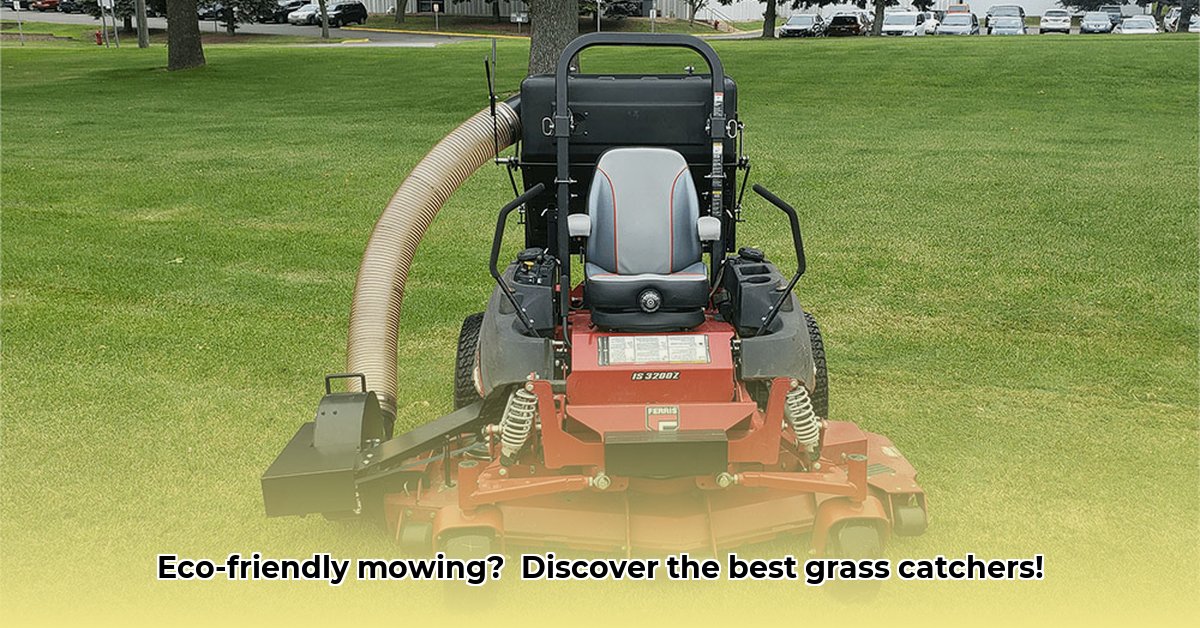
Choosing the right grass catcher for your lawn tractor isn't just about neatness; it's about sustainable lawn care. This guide explores how to select the perfect catcher and integrate it into an eco-friendly lawn care routine. For larger properties, consider a tow-behind rake for efficient debris removal.
Why Use a Grass Catcher? Beyond a Neat Lawn
A grass catcher offers several benefits beyond a tidy lawn. Firstly, it prevents scattered clippings, which can harbor disease and pests, contributing to a healthier lawn. Secondly, collected clippings are a valuable resource. They're rich in nutrients and ideal for composting, creating a natural fertilizer that reduces or eliminates the need for chemical alternatives and promoting a greener environment. Finally, even with a mulching mower, a dedicated catcher offers more control over nutrient distribution, achieving a more even spread for optimal composting. Wouldn't you agree that a healthier, more sustainable lawn is worth the effort?
Finding the Right Grass Catcher: Key Considerations
Selecting the right grass catcher involves careful consideration of several factors. These factors influence both the efficiency of the process and the overall environmental impact.
Compatibility and Capacity
- Tractor Compatibility: Always check your lawn tractor's owner's manual to ensure compatibility. Using an incompatible catcher can damage your equipment.
- Lawn Size: Consider your lawn's size to determine the necessary catcher capacity. A larger lawn requires a larger-capacity catcher to reduce emptying frequency. This saves time and effort in the long run.
Practicality and Durability
- Ease of Emptying: Choose a catcher with a design that allows for smooth, efficient emptying. This minimizes the time and effort required for this essential task.
- Materials and Durability: Durable, high-quality materials mean a longer-lasting catcher, reducing waste from frequent replacements. Consider the long-term cost-effectiveness and environmental impact of the materials.
Using Your Grass Catcher: A Simple, Step-by-Step Guide
Using a grass catcher is straightforward. Follow these steps for optimal results:
- Selection: Choose a catcher compatible with your tractor and appropriate for your lawn's size.
- Installation: Carefully install the catcher following the manufacturer's instructions.
- Mowing: Mow your lawn as usual.
- Emptying and Composting: Empty the collected clippings into your compost bin once the catcher is full.
- Compost Application: Utilize the nutrient-rich compost to fertilize your lawn organically.
Grass Catcher Materials: Environmental Considerations
The material of your grass catcher significantly impacts its environmental footprint. Many are made of plastic, contributing to landfill waste. However, more sustainable, biodegradable options are emerging, offering a longer-term eco-friendly solution, although often with a slightly higher initial cost. What are your priorities: affordability or environmental sustainability?
Beyond the Catcher: Holistic Sustainable Lawn Care
Using a grass catcher is a part of a broader sustainable lawn care strategy. Consider the following:
- Smart Watering: Deep, infrequent watering promotes strong root systems, reducing water waste.
- Climate-Appropriate Grass: Choosing grass varieties suited to your climate minimizes stress and reduces the need for extra water and fertilizer.
- Minimizing Chemical Use: Organic fertilizers and pest control reduce harmful chemical runoff.
- Optimal Mowing Height: Avoiding scalping your lawn helps retain moisture and reduces weed growth.
Dr. Emily Carter, Professor of Environmental Science at the University of California, Berkeley, states, "Sustainable lawn care is not merely a trend, but an essential step toward environmental stewardship. Integrating practices like composting and reducing chemical use significantly impacts ecological health."
Weighing the Pros and Cons: A Balanced Perspective
Using a grass catcher presents both advantages and disadvantages:
| Feature | Pros | Cons |
|---|---|---|
| Neatness | Immaculate lawn, free from unsightly clippings. | Requires more frequent emptying. |
| Composting | Easy access to nutrient-rich compost for natural lawn fertilization. | Requires a composting system; adds to the overall lawn care process. |
| Disease Control | Reduces disease spread by eliminating leftover clippings. | Adds to the overall time commitment. |
| Cost | Initial investment cost. | Can add to replacement costs over time. |
| Environmental Impact | Reduced need for chemical fertilizers; promotes sustainability. | Environmental impact depends on catcher materials. |
Sustainable Practices Beyond the Catcher: Smart Choices for a Greener Lawn
Adopting a truly sustainable approach involves more than just the grass catcher. Here are some additional strategies:
- Sharp Blades: Sharp mower blades ensure clean cuts, improving both grasscycling and collection efficiency.
- Appropriate Mowing Height: Adjust mowing height according to grass type and climate.
- Mulching Mower Consideration: Mulching mowers finely chop clippings, aiding decomposition in grasscycling.
- Natural Fertilization: Reduce or eliminate chemical fertilizers, relying on compost or grasscycling.
- Water Conservation: Water deeply but infrequently to promote deep root growth and drought tolerance.
Remember, sustainable lawn care requires a holistic approach. By selecting the right grass catcher and incorporating these practices, you can enjoy a beautiful, healthy lawn while minimizing your environmental footprint.